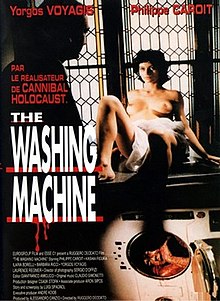| The Washing Machine | |
|---|---|
 | |
| Directed by | Ruggero Deodato |
| Screenplay by | Luigi Spagnol[1] |
| Story by | Luigi Spagnol[1] |
| Produced by |
|
| Starring |
|
| Cinematography | Sergio D'Offizi[1] |
| Edited by | Gianfranco Amicucci[1] |
| Music by | Claudio Simonetti[1] |
Production companies |
|
Release date |
|
Running time | 90 minutes |
| Countries |
|
The Washing Machine (Italian: Vortice Mortale) is a 1993 giallo film directed by Ruggero Deodato.
Plot[edit]
Inspector Alexander Stacev is called to the house of three sisters, Ludmilla, Vida and Maria, after Ludmilla claims to have found the dismembered body of Vida's pimp boyfriend Yuri inside their washing machine. When he arrives and finds no body he tells them there is no case, putting it down to a drunken hallucination. The sisters think otherwise and follow and pester him about the disappearance of Yuri, luring him into their strange world.
Cast[edit]
- Philippe Caroit as Inspector Alexander Stacev
- Ilaria Borrelli as Maria 'Sissy' Kolba
- Katarzyna Figura as Vida Kolba
- Barbara Ricci as Ludmilla Kolba
- Laurence Regnier as Nikolai
- László Borbély as Music Teacher
- Claudia Pozzi as Irina
- Yorgo Voyagis as Yuri Petkov
- Vilmos Kolba as Blind School Instructor
- Károly Medriczky as German Tourist #1
- Sándor Boros as German Tourist #2
- Tamás Pintér as Male Orchestra Singer
- Ágnes Dávid as Female Orchestra Singer
Production[edit]
The Washing Machine was based on a stage play La Lavatrice by Luigi Spagnol.[2] It was shot in Budapest.[2] Deodato described the film as being "made precariously" and without distribution.[3]
Release[edit]
The Washing Machine was released in 1993 and did not find distribution in Italy.[2] The film was released on home video in the Netherlands as The Washing Machine.[4] The Washing Machine was released in 2014 on DVD in the UK by Shameless Screen Entertainment. [5]
Reception[edit]
From retrospective reviews, Adrian Luther Smith in his book on Italian giallo found the film to be "one of [Deodato]'s better films" and that Claudio Simonetti's score was "one of the best in recent years."[4]
Deodato gave different reactions to the film on different occasions. In one interview he stated he wasn't happy with the film as the casting was wrong and that the film "was made too quickly… I can only say that I am not at all pleased with the final result because it's a very intimate movie and should have had well-known actors, which it does not. So, after the first few minutes it collapses."[6] In another interview, Deodato described the film as "interesting" and that it was an "erotic-giallo, with a horror tinge to it" and having a Rashomon-theme throughout with characters having different points of view.[3]
References[edit]
- ^ a b c d e f g Luther Smith 1999, p. 125.
- ^ a b c d Curti 2022, p. 378.
- ^ a b Ercolani 2019, p. 231.
- ^ a b Luther Smith 1999, p. 127.
- ^ "THE WASHING MACHINE". Shameless-Films. Retrieved 4 July 2021.
- ^ Fenton 1999, p. 112.
Sources[edit]
- Curti, Roberto (2022). Italian Giallo in Film and Television. McFarland. ISBN 978-1-4766-8248-8.
- Ercolani, Eugenio (2019). Darkening the Italian Screen. McFarland. ISBN 978-1-4766-3538-5.
- Fenton, Harvey (1999). Cannibal Holocaust: And the Savage Cinema of Ruggero Deodato. FAB Press. ISBN 0-9529260-4-0.
- Luther Smith, Adrian (1999). Blood & Black Lace. Stray Cat Publishing. ISBN 0-9533261-1-X.